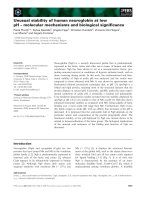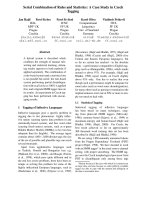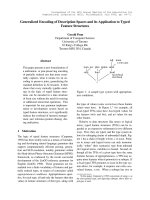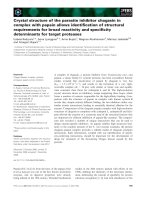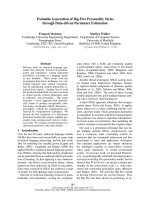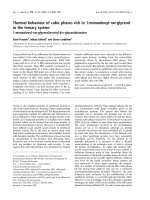Báo cáo khoa học: Thermal stability of homologous functional units of Helix pomatia hemocyanin does not correlate with carbohydrate content potx
Bạn đang xem bản rút gọn của tài liệu. Xem và tải ngay bản đầy đủ của tài liệu tại đây (216.56 KB, 8 trang )
Thermal stability of homologous functional units of
Helix pomatia hemocyanin does not correlate with
carbohydrate content
Betu
¨
l T. Yesilyurt
1
, Constant Gielens
1
and Filip Meersman
2
1 Division of Biochemistry, Molecular and Structural Biology, Department of Chemistry, Katholieke Universiteit Leuven, Belgium
2 Division of Molecular and Nanomaterials, Department of Chemistry, Katholieke Universiteit Leuven, Belgium
Hemocyanins are complex respiratory molecules
found in the hemolymph of many arthropods and
molluscs [1,2]. The hemocyanin of the roman snail
Helix pomatia consists of three components: two
a-components (a
D
-HpH and a
N
-HpH) and a b-com-
ponent (b-HpH). They all show the cylindrical quater-
nary structure (diameter 35 nm, height 38 nm),
typical of gastropodan hemocyanins, comprising 20
subunits with a molecular mass of approximately
450 kDa each [1]. The b-HpH is composed of only
one type of subunit (b-subunit), whereas both
a-HpHs are composed of two types (a and a¢ subunits)
[3]. Owing to the subunit homogeneity, structural
investigations on HpH have mainly been performed
on the b-component. The subunits themselves are
folded into eight globular functional units (FUs)
designated a to h from the N-terminus on (Fig. 1).
Above pH 8, b-HpH dissociates into dimers
(M
r
9 · 10
5
) of subunits [4]. Limited trypsinolysis of
these dimers yields the fragments HpH- abc and HpH-ef
and the FUs HpH-d, HpH-g and HpH-h (occurring
as dimers h
2
) [5]. Further limited proteolysis of the
Keywords
disulfide bridge; FTIR spectroscopy;
functional unit; glycosylation; hemocyanin
Correspondence
F. Meersman, Division of Molecular and
Nanomaterials, Department of Chemistry,
Katholieke Universiteit Leuven,
Celestijnenlaan 200F, B-3001 Leuven,
Belgium
Fax: +32 16 327990
Tel: +32 16 327355
E-mail: fi
(Received 12 February 2008, revised 11
April 2008, accepted 15 May 2008)
doi:10.1111/j.1742-4658.2008.06507.x
The thermal stability of the eight functional units of b-hemocyanin of the
gastropodan mollusc Helix pomatia was investigated by FTIR spectros-
copy. Molluscan hemocyanin functional units have a molecular mass of
approximately 50 kDa and generally contain three disulfide bridges: two in
the mainly a-helical N-terminal domain and one in the C-terminal b-sheet
domain. They show more than 50% sequence homology and it is assumed
that they adopt a similar conformation. However, the functional units of
H. pomatia b-hemocyanin, designated HpH-a to HpH-h, differ considerably
in their carbohydrate content (0–18 wt%). Most functional units are excep-
tionally stable with a melting temperature in the range 77–83 °C. Two
functional units, HpH-b and HpH-c, however, have a reduced stability with
melting temperature values of 73 °C and 64 °C, respectively. Although the
most glycosylated functional unit (HpH-g) has the highest temperature
stability, there is no linear correlation between the degree of glycosylation
of the functional units and the unfolding temperature. This is ascribed to
variations in secondary structure as well as in glycan attachment sites.
Moreover, the disulfide bonds might play an important role in the confor-
mational stability of the functional units. Sequence comparison of mollus-
can hemocyanins suggests that the less stable functional units, HpH-b and
HpH-c, similar to most of their paralogous counterparts, lack the disulfide
bond in the C-terminal domain.
Abbreviations
FU, functional unit; HpH, Helix pomatia hemocyanin; T
m
, melting temperature.
FEBS Journal 275 (2008) 3625–3632 ª 2008 The Authors Journal compilation ª 2008 FEBS 3625
fragments Hp H-abc and HpH-ef with subtilisin allows
each of the FUs to be isolated [6].
The FUs are disulfide bond containing entities with
a molecular mass of approximately 50 kDa. The cry-
stal structures are available for a cephalopod FU,
OdH-g, from Octopus dofleini hemocyanin [7] and for
a gastropod FU, RtH2-e, from Rapana thomasiana
hemocyanin [8]. The polypeptide chain is folded into
two distinct domains, a mainly helical N-terminal
domain containing the active site and a C-terminal
domain with b-sheet structure. The active site consists
of six histidine residues coordinating two copper
atoms. The molluscan hemocyanin FUs are very sim-
ilar in sequence [9]. Hence, it is generally assumed that
their tertiary structures are comparable [10].
Most hemocyanins are glycoproteins. The b-HpH
contains 7% carbohydrate, with the individual FUs
having a variable carbohydrate content (Table 1)
[11,12]. The glycosylation sites were located in FUs
HpH-d, HpH-e, HpH-g and HpH-h; FUs HpH-c and
HpH-f are devoid of carbohydrate [11]. For FUs
HpH-a and HpH-b, the glycan attachment sites are not
yet known. The Asn387 residue at the carboxyl termi-
nus, using the numbering of HpH-d [13], is the most
conserved glycosylation site [12]. The carbohydrate
moiety of molluscan hemocyanins has received particu-
lar interest because of its possible role in the immuno-
stimulatory properties of these proteins [14]. Recently,
it was demonstrated that the glycan chains are
involved in the antigenicity of R. thomasiana hemocya-
nin [15]. In the present study, we investigated the ther-
mal stability of the homologous FUs of b-hemocyanin
of H. pomatia and considered the role of the degree of
glycosylation and the secondary structure variability
on the observed differences in stability.
Results
The thermal stability of the FUs was monitored by
FTIR spectroscopy. In particular, the amide I¢ region
is sensitive to the secondary structure of the protein
[16]. This spectral region is therefore generally used
to follow conformational changes as a function of
temperature.
At 25 °C, the amide I¢ region of all b-HpH FUs
consists of a broad band. Deconvolution and fitting of
the spectrum showed the presence of several bands at
different wavenumbers. The positions of the compo-
nent bands of the amide I¢ region for FU HpH-d are
shown in Fig. 2. The structural features and the ther-
mal behaviour of this FU is representative of all other
FUs. Therefore, we limit our discussion to HpH-d.
The peak positions and band assignments are summa-
rized in Table 2. The band at 1610 cm
)1
is generally
assigned to the side chain contributions of the amino
acids. After the deconvolution and fitting of the infra-
red spectra of all FUs in the amide I¢ region, the per-
centages of a-helix and b-sheet structures in the native
proteins were calculated. The results of the fitting are
in agreement with previous work that investigated the
percentages of a-helix with CD (Table 3).
Fig. 1. Cartoon of a b-HpH subunit and its eight FUs (a to h). The
cleavage sites, on limited proteolysis, of trypsin (solid) in the sub-
unit and of subtilisin (dashed) in fragments HpH-abc and HpH-ef are
indicated by arrows.
Table 1. Carbohydrate content and melting temperatures of b-HpH
functional units (FUs).
FU
Carbohydrate
content (wt%) T
m
(°C)
HpH-a 7.4
a
76.9 ± 0.7
HpH-b 11.6
a
72.7 ± 0.2
HpH-c 0
a
64.4 ± 0.5
HpH-d 6.0
a
80.9 ± 0.5
HpH-e 6.0
b
78.4 ± 0.3
HpH-f 0
b
79.4 ± 0.9
HpH-g 17.6
a
83.3 ± 0.7
HpH-h 6.6
a
80
HpH-abc 6.3
a
77.8 ± 1.4
a
Wood et al. [11].
b
Gielens et al. [12].
Fig. 2. Secondary structure analysis of FU HpH-d from b-HpHat
25 °C. Curve-fitting of the Fourier self-deconvoluted amide I¢ band
(1600–1700 cm
)1
). The Gaussian curves underneath the curve rep-
resent the various contributions to the amide I¢ band. The peak
assignment is given in Table 2.
Thermal stability of hemocyanin functional units B. T. Yesilyurt et al.
3626 FEBS Journal 275 (2008) 3625–3632 ª 2008 The Authors Journal compilation ª 2008 FEBS
Figure 3A shows the changes in the amide I¢ band
of FU HpH-d upon heating. As the temperature
increases, the intensity of the band at 1650 cm
)1
,
which is assigned to a-helix structure, gradually
decreases and the formation of two new bands at
1618 and 1683 cm
)1
is observed. The simultaneous
appearance of these two bands is indicative of the for-
mation of a b-sheet rich aggregate in which the strands
are oriented in an antiparallel manner [17]. The
unfolding process is irreversible. A white gel due to
the aggregation could be observed by eye.
Figure 3B compares the deconvoluted spectra at
25 °C and 90 °C. Apart from the IR aggregation
bands at 1618 and 1683 cm
)1
, a clear peak can still
be observed at 1650 cm
)1
with a shoulder at
1640 cm
)1
at 90 °C, which correspond to peaks
found at 25 °C. This suggests that only partial unfold-
ing has taken place. In other words, some secondary
structure persists, even at high temperatures. Note,
however, that the ratio of the peaks at 1640 and
1650 cm
)1
has changed at high temperature. Because
the b-sheet structure absorbs in the region 1620–
1640 cm
)1
region, it is most likely that any change
here indicates a loss of b-sheet structure.
If we plot the intensities at 1618 and 1647 cm
)1
versus temperature, a sigmoid curve is found with a
midpoint temperature (T
m
) of approximately 81 °C
(Fig. 4). The peak at 1647 cm
)1
corresponds to the
band maximum. It is assumed that this peak reflects
mainly the changes in a-helix structure. Both graphs
yield the same midpoint values, implying that the loss
of a-helix structure is concomitant with the appearance
of the aggregation bands.
The midpoint temperatures for all FUs as well as
for the HpH-abc fragment are listed in Table 1. In a
recent study, the transition midpoints of the FUs
HpH-d and HpH-g of b-HpH in glycine-NaOH buffer
(pH 9.6) were determined by differential scanning calo-
Table 2. Secondary structure assignment of the peaks in the
amide I¢ region
a
.
Wavenumber (cm
)1
) Secondary structure
1617
b
Intermolecular b-sheet
1627 b-Sheet
1635 b-Sheet
1644 Disordered
1654 a-Helix
1662 Turn
1671 Turn
1684
b
Intermolecular b-sheet
a
After Barth & Zscherp [16].
b
Present in the aggregated state.
Table 3. Secondary structure content of b-HpH functional units
(FUs). Values (%) determined by curve-fitting of the amide I¢ band
of the respective FUs at 25 °C.
FU
a-Helix b-Sheet
FTIR CD
a
FTIR
HpH-a 39.0 45 29.7
HpH-b 25.0 23 25.0
HpH-c 24.4 30 32.3
HpH-d 23.1 26 29.8
HpH-e 27.9 24 35.2
HpH-f 15.0 19 32.1
HpH-g 31.4 30 16.3
HpH-h 21.3 25 20.6
a
CD spectra between 200 and 250 nm were obtained on a Cary
CD 61 spectropolarimeter (Varian, Monrovia, CA, USA) in 25 m
M
borax-HCl (pH 8.2) at 20 °C. The spectra were analysed using a
dataset of reference protein spectra [39] (M. Finotto, C. Gielens
and G. Pre
´
aux, unpublished data).
Fig. 3. Temperature dependence of the amide I¢ region of FU HpH-d
of b-HpH. (A) Non-deconvoluted spectra are shown every 5 °Cin
the range 25–90 °C. The arrows indicate the direction of the spec-
tral changes with temperature. (B) Fourier-deconvoluted IR spec-
trum of FU HpH-d in the amide I¢ region at 25 °C (solid line) and
90 °C (dotted line).
B. T. Yesilyurt et al. Thermal stability of hemocyanin functional units
FEBS Journal 275 (2008) 3625–3632 ª 2008 The Authors Journal compilation ª 2008 FEBS 3627
rimetry [18]. The respective melting points were 76 °C
for HpH-d and 85 °C for HpH-g, which is in rather
fair agreement with our findings, given the differences
in experimental conditions.
To obtain further insight into the unfolding process,
we calculated the difference spectra as a function of
temperature. These are obtained by subtracting the
spectrum at 25 °C from the spectra at higher tempera-
tures. The positive peaks indicate an intensity increase
due to newly formed structures at that wavenumber.
Conversely, negative peaks indicate an intensity
decrease and the loss of native structure as a result
of the temperature increase. The difference spectra of
HpH-d (Fig. 5A) are dominated by two strong positive
peaks at 1618 and 1683 cm
)1
, indicative of the
aggregation of the thermally denatured proteins. In
addition, in the early stages of the heat denaturation
process, a negative peak can be observed at
1632 cm
)1
(Fig. 5B). This suggests at least part of
the b-sheet structure unfolds prior to the unfolding
of a-helix and the formation of aggregates. Note that
the formation of aggregates cannot be fully excluded
in the temperature range 25–60 °C because a small
population of aggregate may go undetected.
The early onset of protein aggregation is particularly
apparent from the intensity changes at 1618 cm
)1
in
the case of FU HpH-h (Fig. 6). Above 55 °C, the
intensity at 1618 cm
)1
starts to increase, with a fur-
ther increased slope in the range 75–85 °C. This made
it impossible to fit the data to a single sigmoidal curve.
Therefore, the T
m
was estimated visually, assuming the
steepest part of the curve reflects the global unfolding
of HpH-h.
Discussion
The thermal stability of the eight FUs of b-HpH was
investigated. Six of these FUs were found to be highly
temperature resistant with a T
m
close to 80 °C,
whereas the two remaining FUs, HpH-c and, to a les-
ser extent, HpH-b, are less stable. The reduced stability
Fig. 5. Difference spectra for FU HpH-d. Difference spectra (DA)
were obtained by subtracting the spectrum at 25 °C from all other
spectra (A) in the temperature range 25–90 °C and (B) detail of the
changes in the range 25–60 °C.
Fig. 6. Intensity of the band at 1617.9 cm
)1
versus temperature for
FU HpH-h of b-HpH. Dots represent the experimental data and the
full line is a guide to the eye.
Fig. 4. Temperature dependence of intermolecular b-sheet and
a-helix structures. Intensity of the bands at 1617.9 cm
)1
(d) and
1646.9 cm
)1
( ) versus increasing temperature for FU HpH-d of
b-HpH. These bands are assigned to intermolecular b-sheet and
a-helix structures, respectively. Dots represent the experimental
data, and the full lines are the fitted curves.
Thermal stability of hemocyanin functional units B. T. Yesilyurt et al.
3628 FEBS Journal 275 (2008) 3625–3632 ª 2008 The Authors Journal compilation ª 2008 FEBS
of HpH-c is particularly striking because it is destabi-
lized by 15 °C compared to HpH-f, which also lacks
carbohydrate groups. A possible explanation for the
lower stabilities of HpH-b and HpH-c, discussed at
length below, is that both FUs lack a third disulfide
bridge in the C-terminal domain. Note, however, that
the HpH-abc fragment, from which HpH-b and HpH-c
are isolated, has a relatively high stability (Table 1),
suggesting that the interactions within the fragment
stabilize these FUs.
The b-domain unfolds prior to the a-domain
The observed unfolding behaviour of the FUs suggests
that the C-terminal b-domain is less stable than the
a-domain. This is not surprising because the a-domain
contains the active site and the presence of the copper
atoms will contribute to the stability of the protein. It
has previously been shown for the subunit of b-HpH
that the apo-form (copper-deprived) of the protein is
destabilized by approximately 20 °C [19]. In addition,
the a-domain also contains a cysteine-histidine thioe-
ther bond and, for the known structures of OdH-g and
RtH2-e [7,8], two out of three disulfide bridges, which
will contribute to its stability [20]. The lower stability
of the b-domain might explain the pronounced early
onset of the aggregation of FU HpH-h which has, in
comparison with the other FUs (HpH-a-g), an extra
stretch of approximately 100 amino acids at the C-ter-
minal end of the polypeptide chain [12]. This tail
extension is generally found in gastropod hemocyanins
[21], and has also been documented for the bivalve
Nucula nucleus [20]. Note that, in the case of HpH-h,
the C-terminal domain also lacks an attached glycan
structure [12]. The aggregation propensity may be
further enhanced by the fact that HpH-h is also resp-
onsible for the dimerization of two subunits via nonco-
valent interactions [11].
Thermal stability does not correlate with
carbohydrate content
Glycoproteins can be found in most organisms, includ-
ing Archaea and bacteria [22]. The carbohydrate moi-
ety plays an important role in protein trafficking and
in molecular recognition phenomena. It also influences
protein folding and, in some cases, glycosylation
defects are associated with human diseases [22,23].
Moreover, it is commonly observed that the glycosy-
lated protein has an increased thermal stability com-
pared to the nonglycosylated form and that it is less
susceptible to proteolysis [24–26]. The increased ther-
mal stability, typically in the order of 4 °C [27,28], is
generally explained by the fact that the carbohydrate
moiety increases the chain stiffness near its attachment
site. As a result, the entropy gain upon unfolding is
reduced and the native-unfolded equilibrium is shifted
slightly to the left [24–26]. Hence, we expected to find
an increase in T
m
with increasing glycosylation con-
tent, although it should be emphasized that we have
investigated a series of homologous proteins rather
than a single protein with or without glycans.
To examine the effect of glycosylation on the ther-
mal stability of homologous FUs, we plotted the T
m
values of the eight b- HpH FUs against their carbohy-
drate content (Fig. 7). Although the FU with the high-
est degree of glycosylation, HpH-g, has the highest
melting temperature, there is no overall correlation
between the T
m
and the carbohydrate content. It is
particularly noteworthy that HpH-f, which lacks
glycans, is more stable than the glycosylated FUs
HpH-a, HpH-b and HpH-e. Different glycosylation
sites and glycan structures can affect the stability in
different ways, leading to the observed fluctuation of
T
m
[23,25]. Moreover, as noted above, there is a strik-
ing difference in stability between HpH-c and HpH-f,
which are both devoid of attached glycans.
Influence of the secondary structure variability
on the thermal stability
Molluscan hemocyanin FUs are known to have a large
sequence homology. In the particular cases of HpH-d
and HpH-g, for which the amino acid sequences are
known, there is 56% sequence homology with 46%
identity [13,29]. Taken together with the observation
that the known crystal structures of FUs from two dif-
ferent organisms are very similar [7,8], we conclude
that the FUs of b-HpH are also structurally similar.
However, despite the sequence homology, both FTIR
Fig. 7. Midpoint temperatures (T
m
) versus carbohydrate content of
b-HpH FUs a to h.
B. T. Yesilyurt et al. Thermal stability of hemocyanin functional units
FEBS Journal 275 (2008) 3625–3632 ª 2008 The Authors Journal compilation ª 2008 FEBS 3629
and CD spectroscopy reveal a large variability in
a-helix and b-sheet content of b-HpH FUs (Table 3).
Nevertheless, the lack of any correlation between
secondary structure and stability (data not shown)
suggests that the conformational variability amongst
the FUs is not a determining factor for the differences
in their stabilities.
Reduced stability of HpH-b and HpH-c
The lower stability of FUs HpH-b and HpH-c is possi-
bly explained by the absence of a disulfide bridge in
the C-terminal domain. The stabilizing effect of the
presence of disulfide bonds is well documented [30–32].
There is a rationale for our present hypothesis. Three
disulfide bridges have been localized in b-HpH FUs
HpH-d and HpH-g by protein chemical analysis [33]
and in FUs OdH-g (from O. dofleini hemocyanin) and
RtH2-e (from R. thomasiana hemocyanin) by X-ray
crystallography [7,8]. Two of these disulfide bridges lie
in the N-terminal core domain; the third one is situ-
ated in the C-terminal domain. For all other molluscan
hemocyanin FUs with known sequence, the disulfide
bridges are assumed to be located at corresponding
positions. However, sequence determination by cDNA
analysis performed in our laboratory on the hemo-
cyanin of the cephalopod Sepia officinalis has demon-
strated that FUs SoH-b and SoH-c lack the third
disulfide bridge near the carboxyl terminus (GenBank
accession no. DQ388569 for subunit 1 and DQ388570
for subunit 2). The same absence of the third disulfide
bridge has been observed for FUs OdH-b and OdH-c
from O. dofleini Hc and for FUs NpH-b and NpH-c
from Nautilus pompilius, suggesting this is a general
feature of cephalopod hemocyanin [34,35]. Moreover,
in the case of the gastropods Aplysia californica and
Haliotis tuberculata,FUb lacks a third disulfide
bridge, whereas, for the bivalve N. nucleus, a third
disulfide bridge is missing in both FUs NnH-b and
NnH-c of subunit 2 [20,21]. Given the sequence homo-
logy between various mollusc species, it can be
assumed that the third disulfide bond is also lacking in
FUs HpH-b and HpH-c. In the case of R. thomasiana
hemocyanin, it was found that a reduction of all three
disulfide bridges resulted in a decrease of the T
m
by
approximately 6 °C [30]. This would correspond to
approximately 2 °C per disulfide bridge, assuming
every disulfide bridge contributes equally. This would
explain the differences in T
m
between HpH-b and, for
example, HpH-a. In the case of HpH-c, other factors
must be involved in addition to the absence of stabi-
lizing glycan structures and a third disulfide bridge (see
below).
Molluscan hemocyanin has been shown to possess
phenoloxidase activity [36], which can be increased by
limited proteolysis [37]. Interestingly, we recently
observed that the induced phenoloxidase activity is
extremely high for HpH-c, whereas the induced activity
of HpH-a and HpH-b, which together with HpH-c are
isolated from the same HpH-abc fragment, is negligible
(N. I. Siddiqui and C. Gielens, unpublished data). It is
noteworthy that the thermal stability of HpH-a is com-
parable to that of the HpH-abc fragment, and that,
although HpH-b has a slightly lower stability, only
HpH-c is significantly destabilized upon isolation
(Table 1). It cannot be excluded that the purification
procedure, which involves limited proteolysis, affects
the structure and hence the stability of the other FUs
as well. However, most FUs are found to be extremely
thermally stable with an average T
m
of 80 °C, suggest-
ing the purification procedure does not induce any sig-
nificant conformational changes. Consistent with this
view is the finding that the active sites of the fragments
are well preserved [38], and that an analysis of the
molar mass does not reveal any other fragments than
the expected FUs [6]. Presumably the increased pheno-
loxidase activity of HpH-c reflects a more dynamic
structure, which could be correlated with a lower ther-
mal stability. This is presently under investigation in
our laboratory.
In summary, an analysis of the thermal stabilities of
the FUs of b-hemocyanin from H. pomatia indicates
there is no linear correlation between the stability and
the degree of glycosylation, nor with the secondary
structure content. An intriguing finding is the lower
stability of HpH-b and especially of HpH-c, which is
attributed, at least in part, to the fact that these FUs
have one disulfide bridge less compared to the other
FUs. In future studies, the role of the disulfide bridges
in determining the thermal stability of molluscan
hemocyanin will be explored further.
Experimental procedures
Sample preparation
All functional units (HpH-a-h) were obtained as described
previously [6,37]. Briefly, a solution of didecameric mole-
cules (M
r
9 million) of b-HpH in phosphate buffer
(pH 6.5) was dialysed against Tris–HCl (pH 8.2, I 50 mm),
resulting in the dissociation of the didecamer into dimers of
subunits. The solution was then subjected to limited prote-
olysis with trypsin, yielding the fragments HpH-abc and
HpH-ef and the FUs HpH-d, HpH -g and HpH-h (occurring
as dimers h
2
). The fragments were separated chromato-
graphically and the FUs HpH-a, HpH-b and HpH-c, and
Thermal stability of hemocyanin functional units B. T. Yesilyurt et al.
3630 FEBS Journal 275 (2008) 3625–3632 ª 2008 The Authors Journal compilation ª 2008 FEBS
HpH-e and HpH-f, were isolated from HpH-abc and HpH-ef,
respectively, by limited proteolysis using subtilisin (Fig. 1).
The chromatographically separated FUs were concen-
trated by ultrafiltration and dialysed against Milli-Q water
(Millipore, Molsheim, France) to remove salt ions. Sub-
sequently, the samples were lyophilized using a Savant
Speedvac concentrator (Savant, Farmingdale, NY, USA).
The dried protein was dissolved in deuterated Tris–DCl
buffer (50 mm, pD 8.2) at approximately 50 mgÆmL
)1
. The
protein solution was stored overnight to ensure complete
hydrogen-deuterium exchange of all solvent-exposed hydro-
gens. To remove insoluble material, if any, the solution was
centrifuged at 12 100 g for 3 min before use.
FTIR spectroscopy
Infrared spectra were recorded on a Bruker IFS66 FTIR
spectrometer (Bruker, Ettlingen, Germany) equipped with a
liquid nitrogen cooled mercury cadmium telluride detector
at a nominal resolution of 2 cm
)1
. Each spectrum is the
result of the accumulation and averaging of 256 interfero-
grams. The sample compartment was continuously purged
with dry air to minimize the spectral contribution of atmo-
spheric water.
The heat unfolding was followed using a temperature cell
with CaF
2
windows separated by a 50 lm teflon spacer.
The cell was placed in a heating jacket controlled by a
Graseby Specac Automatic Temperature Controller (Spelac
Ltd, Orpington, UK). The temperature increment was
0.2 °CÆmin
)1
.
Buffer spectra as a function of temperature were recorded
independently and subtracted from the solution spectra at
the corresponding temperature. A baseline correction was
performed in the amide I¢ region (1600–1700 cm
)1
) assuming
a linear baseline. To enhance the component peaks contribut-
ing to the amide I¢ band, the spectra were treated by Fourier
self-deconvolution using the software provided by Bruker
(OS ⁄ 2 version). The lineshape was assumed to be Lorentzian
with a half-bandwidth of 21 cm
)1
and an enhancement fac-
tor k of 1.7 was used. Curve-fitting of the amide I¢ band was
performed using grams ⁄ 32 (Thermo Galactic Inc., Salem,
NH, USA) software after deconvolution of the spectrum
using a c-factor of 11 and a 75% Bessel smoothing function.
Acknowledgement
F. Meersman is a Postdoctoral Fellow of the Research
Foundation-Flanders (FWO-Vlaanderen).
References
1 Pre
´
aux G & Gielens C (1984) Hemocyanins. In Copper
Proteins and Copper Enzymes, Vol. II (Lontie R, ed.),
pp. 159–205. CRC Press, Boca Raton, FL.
2 van Holde KE & Miller KI (1995) Hemocyanins. Adv
Prot Chem 47, 1–81.
3 Lontie R (1983) Components, functional units, and
active sites of Helix pomatia hemocyanin. Life Chem
Rep Suppl 1, 109–120.
4 Witters R & Lontie R (1968) Stability regions and
amino acid composition of gastropod haemocyanins. In
Physiology and Biochemistry of Haemocyanins (Ghiretti
F, ed.), pp. 61–73. Academic Press, London.
5 Gielens C, Verschueren LJ, Pre
´
aux G & Lontie R
(1980) Fragmentation of crystalline b-haemocyanin of
Helix pomatia with plasmin and trypsin. Location of
the fragments in the polypeptide chain. Eur J Biochem
103, 463–470.
6 Gielens C, Verschueren LJ, Pre
´
aux G & Lontie R
(1981) Localization of the domains in the polypeptide
chain of bc-hemocyanin of Helix pomatia.InInverte-
brate Oxygen-Binding Proteins (Lamy J & Lamy J, eds),
pp. 295–303. Marcel Dekker, New York.
7 Cuff M, Miller K, van Holde K & Hendrickson W
(1998) Crystal structure of a functional unit from
Octopus hemocyanin. J Mol Biol 278, 855–870.
8 Perbandt M, Gutho
¨
hrlein EW, Rypniewski W, Idakieva
K, Stoeva S, Voelter W, Genov N & Betzel C (2003)
The structure of a functional unit from the wall of a
gastropod hemocyanin offers a possible mechanism for
cooperativity. Biochemistry 42, 6341–6346.
9 Lieb B, Altenhein B & Markl J (2000) The sequence of
a gastropod hemocyanin (HtH1 from Haliotis tubercula-
ta). J Biol Chem 275, 5675–5681.
10 Gatsogiannis C, Moeller A, Depoix F, Meissner U &
Markl J (2007) Nautilus pompilius hemocyanin: 9 A
˚
cryo-EM structure and molecular model reveal the
subunit pathway and the interfaces between the 70
functional units. J Mol Biol 374, 465–486.
11 Wood EJ, Chaplin MF, Gielens C, De Sadeleer J,
Pre
´
aux G. & Lontie R (1985) Relative molecular mass
of the polypeptide chain of bc-haemocyanin of Helix
pomatia and carbohydrate composition of the functional
units. Comp Biochem Physiol 82(B), 179–186.
12 Gielens C, De Geest N, Compernolle F & Pre
´
aux G
(2004) Glycosylation sites of hemocyanins of Helix
pomatia and Sepia officinalis. Micron 35, 99–100.
13 Drexel R, Siegmund S, Schneider H-J, Linzen B, Gie-
lens C, Pre
´
aux G, Lontie R, Kellermann J & Lottspeich
F (1987) Complete amino-acid sequence of a functional
unit from a molluscan hemocyanin (Helix pomatia ). Biol
Chem. Hoppe-Seyler 368, 617–635.
14 Harris JR & Markl J (1999) Keyhole limpet hemocya-
nin (KLH): a biomedical review. Micron 30, 597–623.
15 Siddiqui NI, Idakieva K, Demarsin B, Doumanova L,
Compernolle F & Gielens C (2007) Involvement of glycan
chains in the antigenicity of Rapana thomasiana hemocy-
anin. Biochem Biophys Res Commun 361, 705–711.
B. T. Yesilyurt et al. Thermal stability of hemocyanin functional units
FEBS Journal 275 (2008) 3625–3632 ª 2008 The Authors Journal compilation ª 2008 FEBS 3631
16 Barth A & Zscherp C (2002) What vibrations tell us
about proteins. Q Rev Biophys 35, 369–430.
17 Meersman F, Smeller L & Heremans K (2002) Compar-
ative Fourier transform infrared spectroscopy study of
cold-, pressure-, and heat-induced unfolding and aggre-
gation of myoglobin. Biophys J 82, 2635–2644.
18 Idakieva K, Gielens C, Siddiqui NI, Doumanova L,
Vasseva B, Kostov G & Shnyrov VL (2007) Irreversible
thermal denaturation of b-hemocyanin of Helix pomatia
and its substructures studied by differential scanning
calorimetry. Z Naturforsch 62a, 499–506.
19 Idakieva K, Siddiqui NI, Parvanova K, Nikolov P &
Gielens C (2006) Fluorescence properties and conforma-
tional stability of the b -hemocyanin of Helix pomatia.
Biochim Biophys Acta 1764, 807–814.
20 Bergmann S, Markl J & Lieb B (2007) The first com-
plete cDNA sequence of the hemocyanin from a
bivalve, the protobranch Nucula nucleus. J Mol Evol 64,
500–510.
21 Lieb B, Boisgue
´
rin V, Gebauer W & Markl J (2004)
cDNA sequence, protein structure, and evolution of the
single hemocyanin from Aplysia californica, an opistho-
branch gastropod. J Mol Evol 59, 536–545.
22 Spiro RG (2002) Protein glycosylation: nature, distribu-
tion, enzymatic formation, and disease implications of
glycopeptide bonds. Glycobiology 12, 43R–56R.
23 Mitra N, Sinha S, Ramya TNC & Surolia A (2006)
N-linked oligosaccharides as outfitters for glycoprotein
folding, form and function. Trends Biochem Sci 31,
156–163.
24 Rudd PM, Joao HC, Coghill E, Fiten P, Saunders MR,
Opdenakker G & Dwek RA (1994) Glycoforms modify
the dynamic stability and functional activity of an
enzyme. Biochemistry 33, 17–22.
25 Yoshimasu MA, Tanaka T, Ahn JK & Yada RY
(2004) Effect of N-linked glycosylation on the aspartic
proteinase porcine pepsin expressed from Pichia pasto-
ris. Glycobiology 14, 417–429.
26 Imperiali B & O’Connor SE (1999) Effect of N-linked
glycosylation on glycopeptide and glycoprotein struc-
ture. Curr Opin Struct Biol 3, 643–649.
27 Wang C, Eufemi M, Turano C & Giartosio A (1996)
Influence of the carbohydrate moiety on the stability of
glycoproteins. Biochemistry 35, 7299–7307.
28 Srimathi S & Jayaraman G (2005) Effect of glycosyla-
tion on the catalytic and conformational stability of
homologous alpha-amylases. Protein J 24, 79–88.
29 Xin X-Q, Gielens C, Witters R & Pre
´
aux G (1990)
Amino-acid sequence of functional unit g from the
b
c
-haemocyanin of Helix pomatia.InInvertebrate
Dioxygen Carriers (Pre
´
aux G & Lontie R, eds),
pp. 113–117. Leuven University Press, Leuven.
30 Georgieva DN, Genov N, Perbandt M, Voelter W &
Betzel C (2004) Contribution of disulfide bonds and cal-
cium to molluscan hemocyanin stability. Z Naturforsch
59c, 281–284.
31 Klink TA, Woycechowsky KJ, Taylor TM & Raines
RT (2000) Contribution of disulfide bonds to the con-
formational stability and catalytic activity of ribonucle-
ase A. Eur J Biochem 267, 566–572.
32 Wedemeyer WJ, Welker E, Narayan M & Scheraga HA
(2000) Disulfide bonds and protein folding. Biochemis-
try 39, 4207–4216.
33 Gielens C, De Geest N, Xin X-Q, Devreese B, Van Bee-
umen J & Pre
´
aux G (1997) Evidence for a cysteine-histi-
dine thioether bridge in functional units of molluscan
haemocyanins and location of disulfide bridges in func-
tional units d and g of the b
c
-haemocyanin of Helix
pomatia. Eur J Biochem 248, 879–888.
34 Miller KI, Cuff ME, Lang WF, Varga-Weisz P, Field
KG & van Holde KE (1998) Sequence of the Octopus
dofleini hemocyanin subunit: structural and evolutionary
implications. J Mol Biol 278, 827–842.
35 Bergmann S, Lieb B, Ruth P & Markl J (2006) The
hemocyanin from a living fossil, the cephalopod Nauti-
lus pompilius: protein structure, gene organization, and
evolution. J Mol Evol 62, 362–374.
36 Salvato B, Santamaria M, Beltramini M, Alzuet G &
Casella L (1998) The enzymatic properties of Octopus
vulgaris hemocyanin: o-diphenol oxidase activity.
Biochemistry 37, 14065–14077.
37 Siddiqui NI, Akosung RF & Gielens C (2006) Location
of intrinsic and inducible phenoloxidase activity in
molluscan hemocyanin. Biochem Biophys Res Commun
348, 1138–1144.
38 Gielens C, Maes G, Zeegers-Huyskens T & Lontie R
(1980) Raman resonance studies of functional fragments
of Helix pomatia b
c
-hemocyanin. J Inorg Biochem 13,
41–47.
39 Hennessey JP Jr & Johnson WC Jr (1981) Information
content in the circular dichroism of proteins. Biochemis-
try 20, 1085–1094.
Thermal stability of hemocyanin functional units B. T. Yesilyurt et al.
3632 FEBS Journal 275 (2008) 3625–3632 ª 2008 The Authors Journal compilation ª 2008 FEBS

